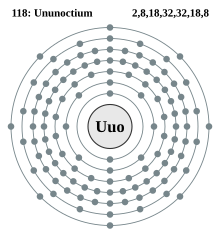Controversy-plagued Element 118, the heaviest atom yet, finally discovered
Saturday, October 14, 2006

Element 118 has been created in experiments conducted in Dubna, Russia by a collaboration of researchers from Russia's Joint Institute for Nuclear Research and from the United States' Lawrence Livermore National Laboratory.
The reaction, producing three atoms of element 118, the heaviest element yet found, through collisions that fused together Californium and Calcium atoms, was observed at Dubna. Although element 118 is too unstable to detect directly, the presence of daughter elements resulting from the decay of element 118 gave clues to its fleeting existence. The discovery was reported in the American Physical Society journal Physical Review C on October 9, 2006.
Researchers at the Lawrence Berkeley National Laboratory previously reported the synthesis of element 118 in 1999, and later retracted their results when subsequent experiments failed to confirm their discovery. It was alleged that a lead researcher, Victor Ninov, fabricated the experimental data that indicated the formation of three element 118 atoms.
Sources
- Rick Weiss. "Scientists Announce Creation of Atomic Element, the Heaviest Yet" — Washington Post, October 17, 2006
- Lawrence Livermore National Laboratory. "Livermore scientists team with Russia to discover element 118" — LLNL News Release, October 16, 2006
- Yu. Ts. Oganessian et al.. "Synthesis of the isotopes of elements 118 and 116 in the 249Cf and 245Cm+48Ca fusion reactions" — Physical Review C, October 9, 2006
- Lynn Yarris. "New Superheavy Elements 116 and 118 Discovered at Berkeley Lab" — Science@BerkeleyLab, June 7, 1999
- LBNL News Office. "Results of Element 118 Experiment Retracted" — Science@BerkeleyLab, July 27, 2001
External links